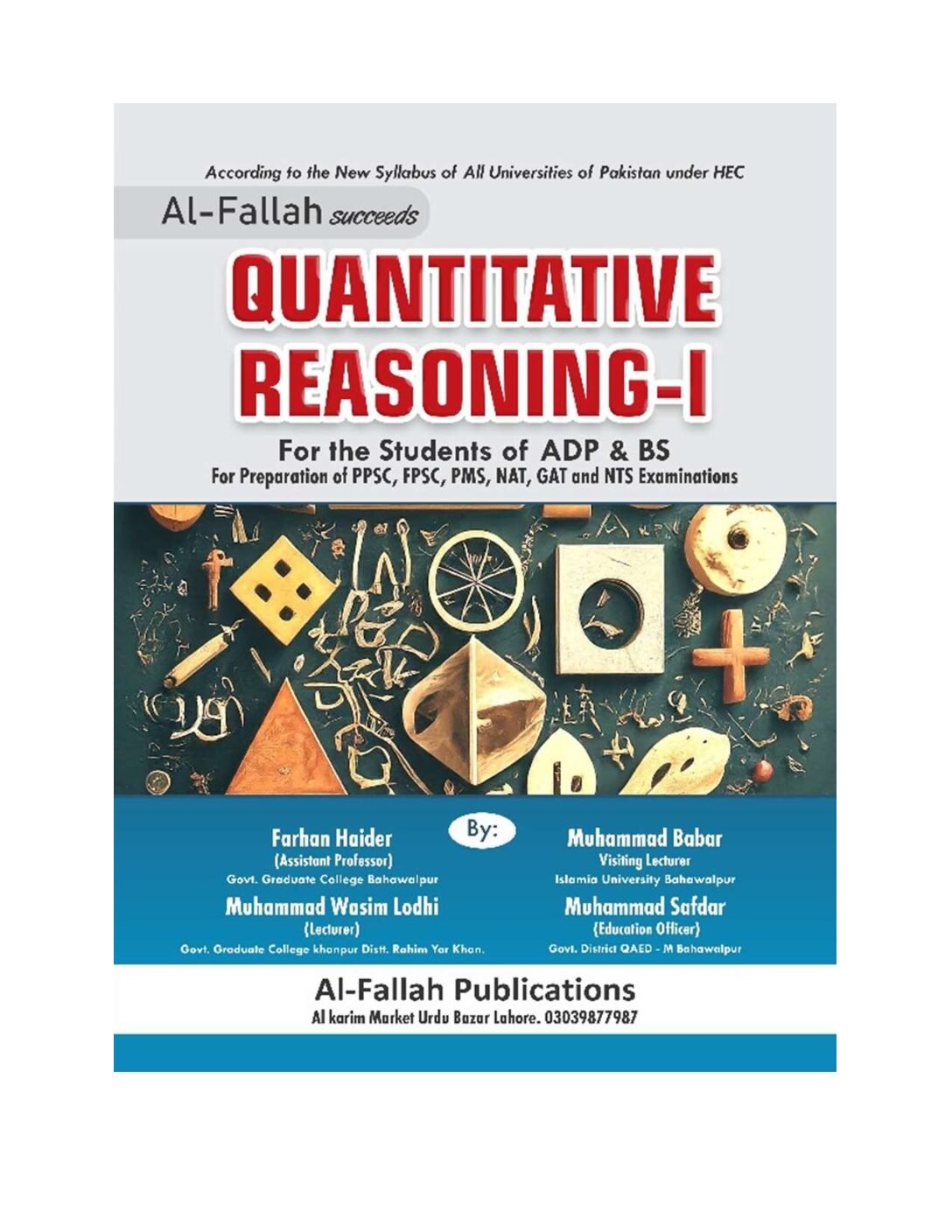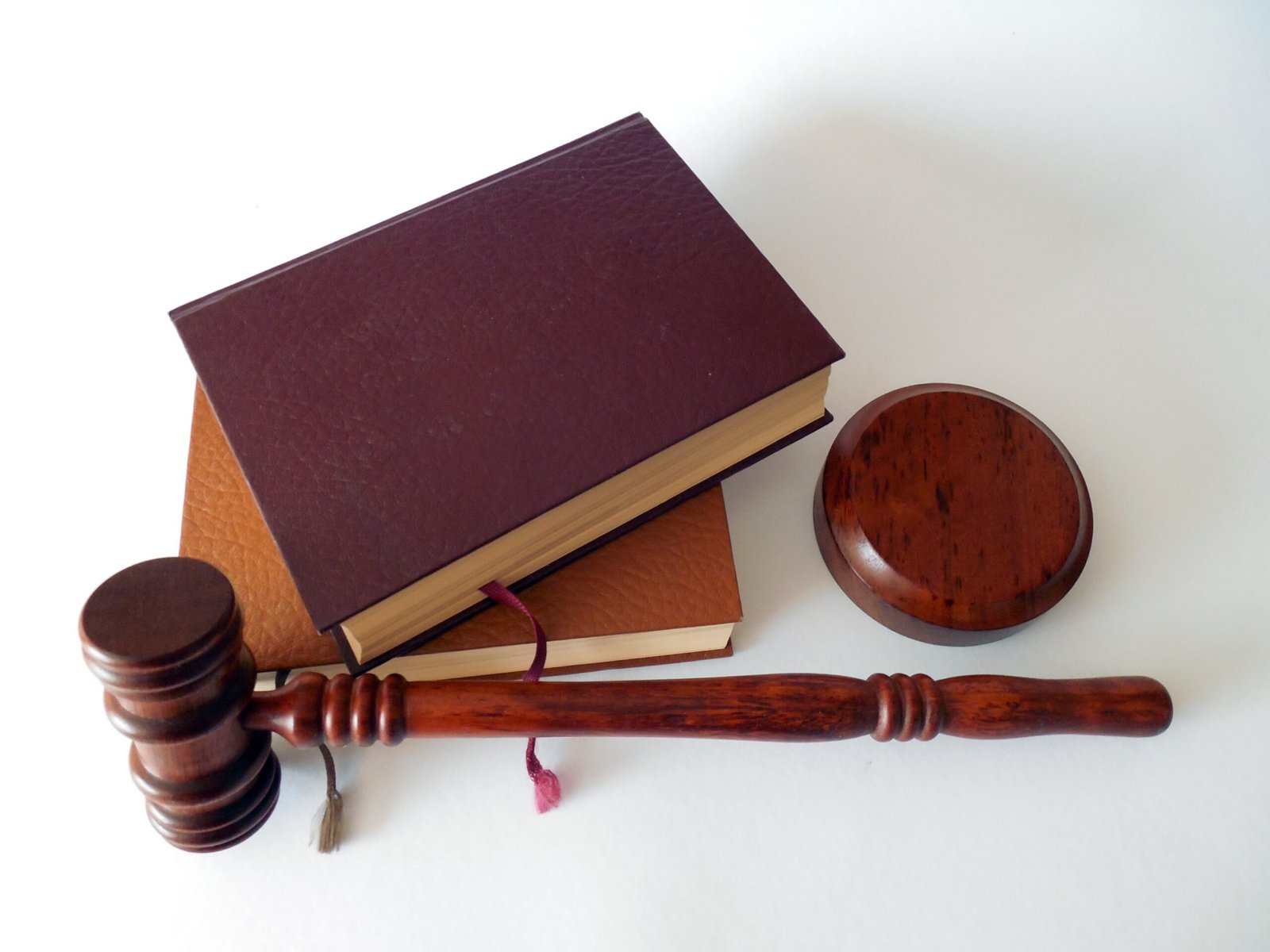QUANTITATIVE REASONING – I MATHEMATICS & STATISTICS
The book Quantitative Reasoning -1 for the students of ADP and BS is a complete and well-organized guide that helps students to understand both Mathematics and Statistics in simple way.

QUANTITATIVE REASONING-I
For the Students of ADP & BS
This book on Quantitative Reasoning is a complete and well-organized guide that helps students understand both Mathematics and Statistics in an easy way. It starts with the basic ideas of quantitative reasoning and slowly moves toward advanced topics step by step. The chapters on numbers, units, ratios, percentages, and data presentation build a strong base for learners. After that, topics like sets, functions, exponents, algebra, and probability make students confident in solving different types of questions. https://www.entertostudy.com/statistical-inference-and-hypothesis-testing/The statistics section is very useful because it explains important ideas like sampling, averages, data spread, and testing hypotheses, T-test and Z-test in simple words. https://www.entertostudy.com/what-is-quantitative-reasoning-definition-components-application-in-every-day-life/The book also includes examples, solved exercises, and model papers, which make it easier for students to prepare for exams. Overall, this book not only teaches how to solve problems but also helps students learn how to think logically and make smart decisions using numbers. It is a perfect guide for anyone who wants to improve their mathematical and reasoning skills.
TABLE OF CONTENTS
| Serial # |
UNIT NUMBER & CONTENTS | Page # |
| 1 | 1. WHAT IS QUANTITATIVE REASONING? | |
| 1.1 Definitions of Quantitative Reasoning | 8 | |
| 1.2 Components of Quantitative Reasoning | 9 | |
| 1.3 Basic Process Of Quantitative Reasoning To Solve Problem | 10 | |
| 1.4 Quantitative Skills & Types of Quantitative Reasoning | 11 | |
| 1.5 Applications of Quantitative Reasoning Skills in Real Life | 12 | |
| 2 | 2. NUMERICAL LITERACY | |
| 2.1. What is Number in Mathematics? | 15 | |
| 2.1.1 Types of Number System | 17 | |
| 2.2 Basic Arithmetic Operations | 19 | |
| 2.2.1 Arithmetic Properties | 20 | |
| PRACTICE EXERCISE | 23 | |
| 3 | 3. UNITS AND THEIR CONVERSIONS | |
| 3.1 Standard Units and Their Types | 30 | |
| 3.2 Dimensions in Mathematics | 35 | |
| PRACTICE EXERCISE | 38 | |
| 3.3. Area | 40 | |
| 3.3.1 Formulas for Calculating Area | 41 | |
| PRACTICE EXERCISE | 46 | |
| 3.4 Perimeter | 50 | |
| 3.4.1 How To Find Perimeter | 51 | |
| 3.4.2 Perimeter Formula | 52 | |
| PRACTICE EXERCISE | 54 | |
| 3.5 Volume | 58 | |
| 3.5.1 Calculation of Volume of 3D Shapes | 59 | |
| PRACTICE EXERCISE | 66 | |
| 4 | 4. RATES, RATIOS, PROPORTIONS AND PERCENTAGE | |
| 4.1 Rates | 69 | |
| 4.1.2 Difference Between Rate and Unit Rate | 70 | |
| 4.1.3 How is Rate Calculated? | 70 | |
| PRACTICE EXERCISE | 72 | |
| 4.2 Ratio | 76 | |
| PRACTICE EXERCISE | 80 | |
| 4.3 Proportion | 84 | |
| 4.3.1 Properties of Proportion | 84 | |
| 4.3.2 Types of Proportion | 84 | |
| 4.3.3 Difference Between Ratio and Proportion | 85 | |
| PRACTICE EXERCISE | 86 | |
| 4.4 Percentage | 88 | |
| 4.4.1 Percentage Formula | 88 | |
| 4.4.2 Percentage Change Between Two Numbers | 89 | |
| 4.4.3 Converting Percentage to Fraction and Vice Versa | 90 | |
| PRACTICE EXERCISE | 96 | |
| 5 | 5. TYPES AND SOURCES OF DATA | |
| 5.1 Introduction of Data | 101 | |
| 5.1.1 Types of Data | 101 | |
| PRACTICE EXERCISE | 103 | |
| 6 | 6. SCALES OF MEASUREMENT | |
| 6.1 Types of Scales of Measurement | 107 | |
| PRACTICE EXERCISE | 110 | |
| 7 | 7. TABULAR AND GRAPHICAL PRESENTATIONS OF DATA | |
| 7.1 Different Methods of Presentation of Data | 113 | |
| 7.1.1 Components / Items of a Table | 114 | |
| 7.1.2 Types of Table | 115 | |
| 7.1.3 Sorting of Data | 116 | |
| PRACTICE EXERCISE | 117 | |
| 7.2 Graphical Presentation of Data | 120 | |
| 7.2.1 Principle of Graphical Presentation of Data | 120 | |
| 7.2.2 Types of Graphs | 121 | |
| 7.2.3 Advantages of Using Graphs | 125 | |
| PRACTICE EXERCISE | 126 | |
| 8 | QUANTITATIVE REASONING EXERCISE USING NUMBER KNOWLEDGE | 131 |
| 9 | 9. FUNDAMENTAL MATHEMATICAL CONCEPTS | |
| 9.1 Basics of Geometry | 136 | |
| 9.1.1 List of Geometric Shapes | 136 | |
| 9.1.2 Geometric Formulas | 141 | |
| 9.1.3 Application of Geometry in Real Life | 142 | |
| PRACTICE EXERCISE | 143 | |
| 9.2 Lines in Geometry | 147 | |
| 9.2.1 Types of Lines in Geometry | 147 | |
| 9.3 Angles in Geometry | 150 | |
| 9.3.1 Types of Angles | 150 | |
| PRACTICE EXERCISE | 155 | |
| 9.4 Circles In Geometry | 164 | |
| 9.4.1 Interior and Exterior of Circle | 164 | |
| 9.4.2 Parts of Circle | 165 | |
| 9.4.3 Circle Formulas | 167 | |
| PRACTICE EXERCISE | 169 | |
| 9.5 Polygons | 173 | |
| 9.5.1 Types of Polygons | 174 | |
| 9.5.2 Polygon Formulas | 179 | |
| 9.5.3 Sample Problems on Types of Polygon | 181 | |
| PRACTICE EXERCISE | 183 | |
| 10 | 10. SETS AND THEIR OPERATIONS | |
| 10.1 Introduction and Basic Definitions of Sets | 188 | |
| 10.1.1 Elements of a Set | 188 | |
| 10.1.2 Representation of Sets in Set Theory | 189 | |
| 10.1.3 Types of Sets | 190 | |
| 10.1.4 Subsets and Their Types | 191 | |
| 10.2 Operations on Set | 192 | |
| 10.2.1 Sets Formulas | 193 | |
| 10.2.2 Properties of Sets | 194 | |
| PRACTICE EXERCISE | 195 | |
| 11 | 11. RELATIONS, FUNCTIONS AND THEIR GRAPHS | |
| 11.1 Relations | 202 | |
| 11.1.1 Presentation of Relations | 202 | |
| 11.1.2 Types of Relation | 204 | |
| 11.1.3 Graphing Relations | 205 | |
| PRACTICE EXERCISE | 207 | |
| 12 | 12. FUNCTIONS | |
| 12.1 Introduction to Function | 209 | |
| 12.1.1 Function Notation | 209 | |
| 12.1.2 How to Evaluate Function | 210 | |
| 12.1.3 Real Life Examples of Function Notation | 210 | |
| 12.1.4 Function, Domain, Range | 211 | |
| 12.1.5 Set- Builder Notation for a Function | 211 | |
| 12.1.6 Types of Functions | 212 | |
| 12.1.7 Composition of Functions | 216 | |
| 12.1.8 Linear and Quadratic Function | 216 | |
| 12.1.9 Inverse of Functions | 217 | |
| 12.1.10 Graphing Functions | 218 | |
| PRACTICE EXERCISE | 220 | |
| 13 | 13. EXPONENTS, FACTORING AND SIMPLIFYING ALGEGBRAIC FUNCTIONS | |
| 13.1 Exponents | 227 | |
| 13.1.1 Properties / Laws of Exponents | 228 | |
| 13.1.2 Adding and Subtracting Exponents | 230 | |
| 13.1.3 Importance of Exponents | 232 | |
| PRACTICE EXERCISE | 233 | |
| 13.2 Factoring of an Algebraic Expression | 238 | |
| 13.2.1 Methods to Factorize Algebraic Expression | 238 | |
| PRACTICE EXERCISE | 242 | |
| 13.3 Simplifying Algebraic Expressions | 244 | |
| 13.3.1 Rules for Simplifying Algebraic Expression | 245 | |
| PRACTICE EXERCISE | 248 | |
| 14 | 14. ALGEBRAIC AND GRAPHICAL SOLUTION OF LINEAR AND QUADRATIC QUATIONS AND INEQUALITIES
|
|
| 14.1 Algebraic and Graphical Solution of Linear Equations and Inequalities | 251 | |
| 14.1.1 Methods to Solve System of Linear Equation | 251 | |
| 14.1.2 Crammer’s Rule | 261 | |
| 14.1.3 Applications of Linear Equations | 262 | |
| PRACTICE EXERCISE | 263 | |
| 14.2 Introduction to Inequalities | 269 | |
| 14.2.1 Properties of Inequalities | 269 | |
| 14.2.2 Solution of Inequalities | 270 | |
| Practice Exercise | 271 | |
| 14.3 Algebraic and Graphical Solution of Quadratic Equations and Inequalities | 272 | |
| 14.3.1 Solution of Quadratic Equation | 272 | |
| 14.3.2 Derivation of Quadratic Equation | 274 | |
| PRACTICE EXERCISE | 276 | |
| 15 | 15. POPULATION AND SAMPLE | |
| 15.1 Population | 281 | |
| 15.1.1 Types of Population | 281 | |
| 15.2 Sample | 283 | |
| 15.2.1 Difference Between Population and Sample | 283 | |
| 15.2.2 Methods of Sampling | 284 | |
| 15.2.3 Population and Sample Formulas | 286 | |
| 15.2.4 Key Steps Involved in Sampling Process | 288 | |
| 15.2.5 Importance of Sampling | 290 | |
| PRACTICE EXERCISE | 291 | |
| 16 | 16. MEASURES OF CENTRAL TENDENCY, DISPERSION AND DATA INTERPRETATION | |
| 16.1 Introduction to Measures of Central Tendency | 295 | |
| 16.1.1 Mean as a Measure of Central Tendency | 296 | |
| 16.1.2 Types of Mean | 297 | |
| 16.1.3 Properties of Mean (Arithmetic) | 298 | |
| 16.1.4 Median as a Measure of Central Tend. | 298 | |
| 16.1.5 Mode as a Measure of Central Tendency | 300 | |
| 16.1.6 Uses of Averages in Different Situations | 304 | |
| PRACTICE EXERCISE | 305 | |
| 16.2 Dispersion in Statistics | 309 | |
| 16.2.1 Types of Measures of Dispersion | 309 | |
| PRACTICE EXERCISE | 321 | |
| 17 | 17. RULES OF COUNTING | |
| 17.1 Fundamental Rules of Counting | 325 | |
| 17.1.1 Permutation | 326 | |
| 17.1.2 Combination | 327 | |
| PRACTICE EXERCISE | 331 | |
| 18 | 18. BASIC PROBABILITY THEORY | |
| 18.1 Introduction to Probability Theory | 335 | |
| 18.1.1 Probability Theory Formula | 338 | |
| PRACTICE EXERCISE | 340 | |
| 19 | 19. INTRODUCTION TO RANDOM VARIABLES AND THEIR PROBABILITY DISTRIBUTIONS | |
| 19.1 Introduction to Random Variables | 345 | |
| 19.1.1 Types of Random Variables | 346 | |
| 19.1.2 Random Variables Formulas | 347 | |
| 19.2 Introduction to Probability Distribution | 349 | |
| 19.2.1 Types of Probability Distribution | 350 | |
| PRACTICE EXERCISE | 353 | |
| 20 | Quantitative Reasoning Exercises Using Fundamental Statistical Concepts; Statistical Inference And Hypothesis Testing | 358 |
| 20.1 Methods of Statistical Inference | 358 | |
| 20.2 Process of Hypothesis Testing | 360 | |
| Introduction to T-Test | 361 | |
| Introduction to Z-Test | 366 | |
| Introduction to Chi-Square Test | 369 | |
| PRACTICE EXERCISE | 372 | |
| 21 | Introduction To Software Tools For Data Analysis; Quantitative Reasoning Exercises Using Fundamental Statistical Concepts | 378 |
| Quantitative Reasoning Exercises Using Software Tools for Data Analysis | 380 | |
| 22 | General Problem-Solving Strategies And Approaches | 383 |
| 23 | Logical Reasoning And Critical Thinking Skills; Decision-Making Using Quantitative Data | |
| 23.1 Logical Reasoning and Quantitative Data | 386 | |
| 23.2 Critical Thinking and Decision Making Using Quantitative Data | ||
| 24 | 24. Real-World Applications And Case Studies | |
| 24.1 Real Word Applications and Quantitative Reasoning | 391 | |
| 24.2 Case Studies showing Quantitative Reasoning | 392 | |
| 25 | Paper Pattern and Guidelines for Mid and Final Exam | 394 |
| 26 | Model Question Papers | 395 |
| 27 | References | 398 |









